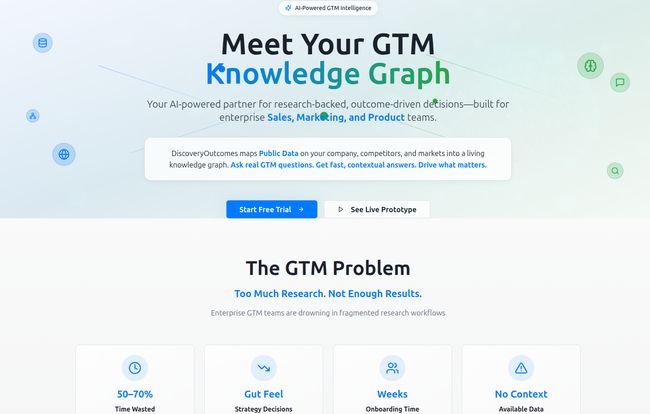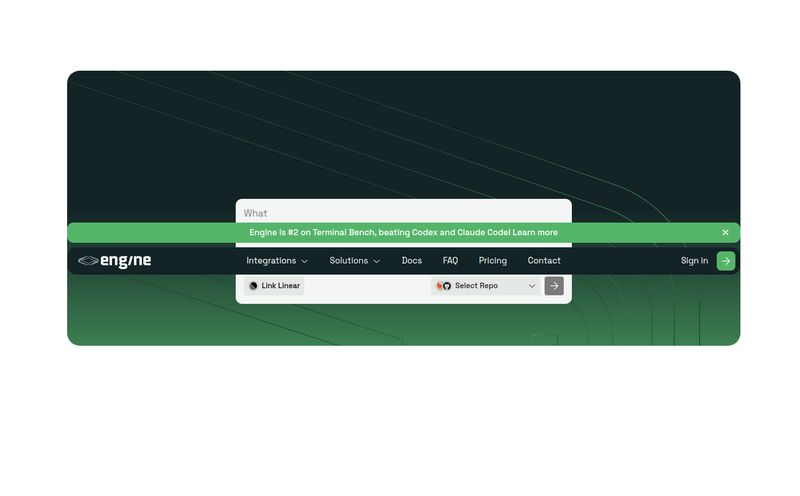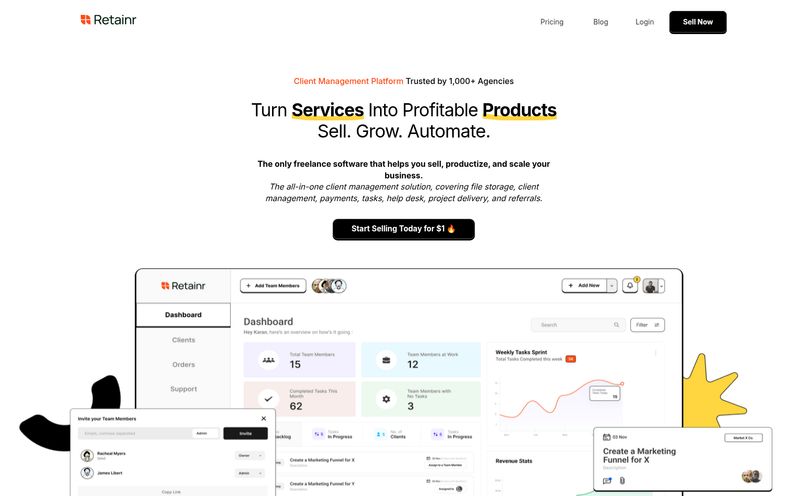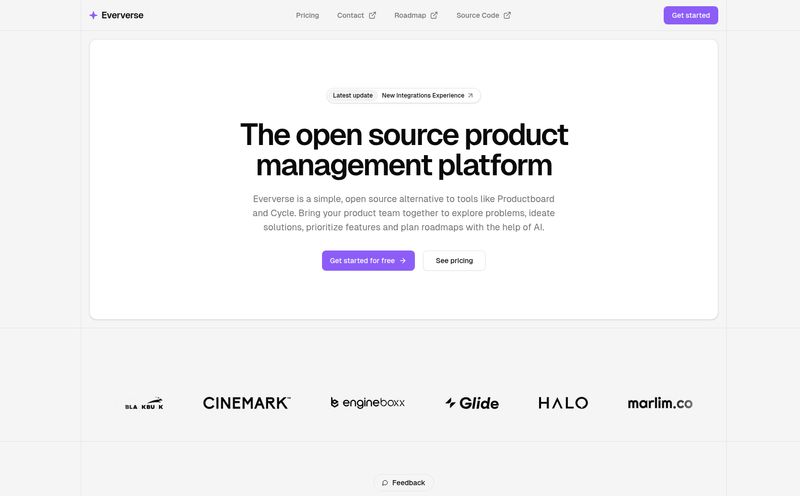If you've ever worked on a go-to-market (GTM) strategy, you know the special kind of beautiful chaos it involves. It's a frantic dance between a dozen spreadsheets, 37 browser tabs of competitor research, Slack channels that move at the speed of light, and that one crucial customer insight buried in a Zendesk ticket from six months ago.
I’ve been there. Neck-deep in data, trying to piece together a coherent narrative for a new product launch. It feels less like strategic planning and more like being a detective in a movie with too many plot threads. You spend weeks gathering intel, and by the time you present it, the market has already shifted. It’s exhausting. And frankly, it feels incredibly inefficient.
So, when I came across a platform called Discovery Outcomes and its flagship feature, the “GTM Knowledge Graph,” my curiosity was definitely piqued. Another AI tool promising to solve all our problems? Maybe. But this one felt a little different. It wasn’t just about generating content; it was about creating a single source of truth. A living, breathing brain for your entire GTM operation. Sounds ambitious, right? Let's see if it holds up.
So What Exactly is This GTM Knowledge Graph Thing?
Imagine if you could take all that public data floating around—your competitor’s latest product launch, shifts in market sentiment, new industry trends—and merge it with all your private company data. We’re talking customer feedback from Gmail, sales call notes from your CRM, help tickets, and internal discussions on Slack. Now, imagine an AI that doesn’t just store this information but actually understands it, connects the dots, and lets you ask it questions in plain English. That’s the core promise of the GTM Knowledge Graph from Discovery Outcomes.
They call their whole platform a “productOS,” which suggests their ambitions are bigger than just GTM. Based on what I've seen, it's designed to be a central nervous system for product, marketing, and sales teams. A way to finally break down the silos that kill momentum.
The GTM Problem We All Pretend Isn't That Bad
The landing page for the GTM Knowledge Graph calls out a statistic that hit a little too close to home: 50-70% of GTM teams are “drowning in fragmented research workflows.” Drowning is the perfect word for it. We all know this pain.
- The Siloed Feeling: Marketing has their competitive intel in a Google Doc, Product has user research in Figma, and Sales has the real gold—customer objections—locked away in call notes. Getting a complete picture is a manual, time-sucking nightmare.
- The Time Suck: They claim it takes “weeks” to spin up GTM knowledge processes. If anything, that feels optimistic. The back-and-forth, the chasing people for information, the double-checking... it's a huge drain on productivity.
- The Lack of Context: Every new campaign or launch feels like starting from square one. All that “tribal knowledge” lives in people’s heads, and when someone leaves the team, that knowledge walks right out the door with them.
This isn't just an inconvenience; it’s a massive competitive disadvantage. While you're busy collating spreadsheets, your competitors are already executing.
How Discovery Outcomes Aims to Be Your GTM Co-pilot
So, how does this platform propose to fix this mess? It seems to come down to a few core capabilities that work together.
A Central Brain That Actually Understands Your Business
The AI agent is built on four main pillars of understanding:
- Company Intelligence: It maps out your own products, portfolio, and strategic narratives. It knows what you sell and why.
- Competitor Analysis: It keeps tabs on what your rivals are doing—their product launches, marketing campaigns, and positioning.
- Market Dynamics: This is the big-picture view. It tracks industry trends, regulatory changes, and broader market shifts.
- Voice of Customer: This might be the most powerful part. It ingests social sentiment, customer feedback, and help-desk tickets to give you a real, unfiltered view of what your customers are actually saying.
The idea of having all four of these streams constantly updated and synthesized in one place is, I have to admit, incredibly appealing.

Visit Discovery Outcomes
Ask Questions, Get Real Answers
This is where it gets fun. Instead of digging through folders or begging your data analyst for a report, you can just… ask. The examples they give are the exact kind of questions that can take days to answer otherwise:
- What are the key value propositions of our top 3 competitors?
- What are the recent product launches or pricing changes from Competitor X?
- What are the most common feature requests from our enterprise customers this quarter?
Getting instant, data-backed answers to these questions would be a game-changer for strategic planning and content creation. Think of the time saved in preparing for a sales call or drafting a new messaging framework. And it provides role-based insights, so the answer a salesperson gets is tailored differently than the one a product manager sees. Very smart.
More Than Just GTM, a Full ProductOS?
Here's where it gets even more interesting. While the main pitch is around the GTM Knowledge Graph, the underlying platform, Discovery Outcomes, has features that go even deeper into the product development lifecycle. I'm talking about things like automated PRD (Product Requirements Document) generation and automated user journey creation. This suggests a tool that doesn’t just help you market the product but helps you build a better one from the start, based on the same pool of centralized data. This closes the loop between what the market wants and what the engineering team builds. A classic struggle for so many companies.
The Tangible Wins: What's the Real-World Impact?
Okay, cool features are nice, but what does this mean for the bottom line? What are the actual outcomes? The platform promises a few things I think any team lead would be thrilled to see.
- Faster Execution: This one’s obvious. Less time on manual research means more time for creative and strategic work. It’s about freeing up your best people to do what they do best.
- Evidence-Backed Decisions: Say goodbye to decisions based on gut feelings or the “loudest voice in the room.” With a tool like this, you can walk into any meeting with a decision backed by real-time market and customer data. That's how you get budget approved.
- Aligned Teams & Better Onboarding: This is a huge, often overlooked benefit. When everyone—from marketing and sales to product and support—is pulling insights from the same source of truth, alignment happens naturally. And for new hires? They can get up to speed on the competitive landscape and customer voice in days, not months. The value of that is immense.
Let's Talk Brass Tacks: Integrations and Potential Downsides
No tool exists in a vacuum. A critical piece of the puzzle is how well it plays with others. Discovery Outcomes seems to get this, listing integrations with the usual suspects: Jira, Figma, Gmail, Slack, MS Teams, and Zendesk. This is good news, as it means the platform can fit into existing workflows rather than forcing a complete overhaul.
Of course, no tool is perfect. And in the spirit of a real-human review, let's consider the potential bumps in the road.
- The Learning Curve: A platform this powerful will likely require a proper onboarding process. It’s not a simple plug-and-play Chrome extension. To get the most out of it, teams will need to invest time in learning its capabilities.
- The AI Reliance Trap: As an SEO and data guy, I love AI. But it’s a co-pilot, not the pilot. There's a risk that teams could become over-reliant on the AI’s suggestions and lose some of their own creative spark or critical thinking. It's all about finding the right balance.
- The Big Question: Pricing: The website doesn't have a public pricing page. This usually means it's an enterprise-level tool with a “Contact Us for a Quote” model. So, it's probably not priced for a solo founder or a very small bootstraped startup. The cost will be a factor.
- SSO Reliance: The sign-in process seems to lean on third-party providers like Google or Microsoft. For most, this is a convenience, but some organizations with very strict IT security policies might see it as a hurdle.
My Final Take: Is Discovery Outcomes Worth a Look?
After digging in, I'm genuinely intrigued. The problem Discovery Outcomes is tackling is one of the biggest, most persistent headaches in modern business. The idea of a self-updating, intelligent GTM knowledge base is more than just a nice-to-have; it feels like the next logical step in how high-performing teams should operate.
Who is this for? I see this being a massive win for mid-to-large-sized companies with complex products or markets. Product Marketers, Competitive Intelligence Analysts, Product Managers, and Sales Enablement leaders would be the power users who could derive incredible value from it.
It's probably overkill for a small team with one product in a simple market. But for anyone feeling that pain of fragmented data and slow execution, Discovery Outcomes is absolutely worth putting on your radar and requesting a demo for.
Frequently Asked Questions
- What is Discovery Outcomes?
- Discovery Outcomes is an AI-powered product management platform, or "productOS," designed to centralize data and streamline workflows. Its core feature is the GTM Knowledge Graph, which synthesizes public and private data to provide actionable insights for go-to-market teams.
- How does the GTM Knowledge Graph work?
- It uses AI to map and analyze data from various sources, including public web data on competitors and markets, as well as private company data from tools like Slack, Zendesk, and your CRM. It creates a connected, queryable knowledge base for your team.
- Who is this tool best for?
- It's ideal for product, marketing, and sales teams in mid-to-large organizations who struggle with siloed information and need to make faster, data-driven GTM decisions.
- What does Discovery Outcomes integrate with?
- It integrates with a range of popular business tools, including Jira, Figma, Gmail, Slack, Microsoft Teams, and Zendesk, allowing it to pull in data from your existing workflows.
- Is there a free trial for Discovery Outcomes?
- Yes, the website offers a "Start Free Trial" option, allowing you to test the platform's capabilities before committing.
- How much does Discovery Outcomes cost?
- Pricing information is not publicly available on their website. This typically indicates a custom or enterprise pricing model, and you'll likely need to contact their sales team for a quote based on your team's size and needs.
Conclusion
In a world overflowing with data, the real challenge isn’t finding information—it’s making sense of it. The constant battle to turn noise into signal is what separates successful GTM strategies from the ones that fall flat. Tools like Discovery Outcomes represent a significant shift, moving us from manual data collection to automated, intelligent synthesis. It’s an exciting development, and one that could finally bring a sense of calm to the beautiful chaos of going to market.



